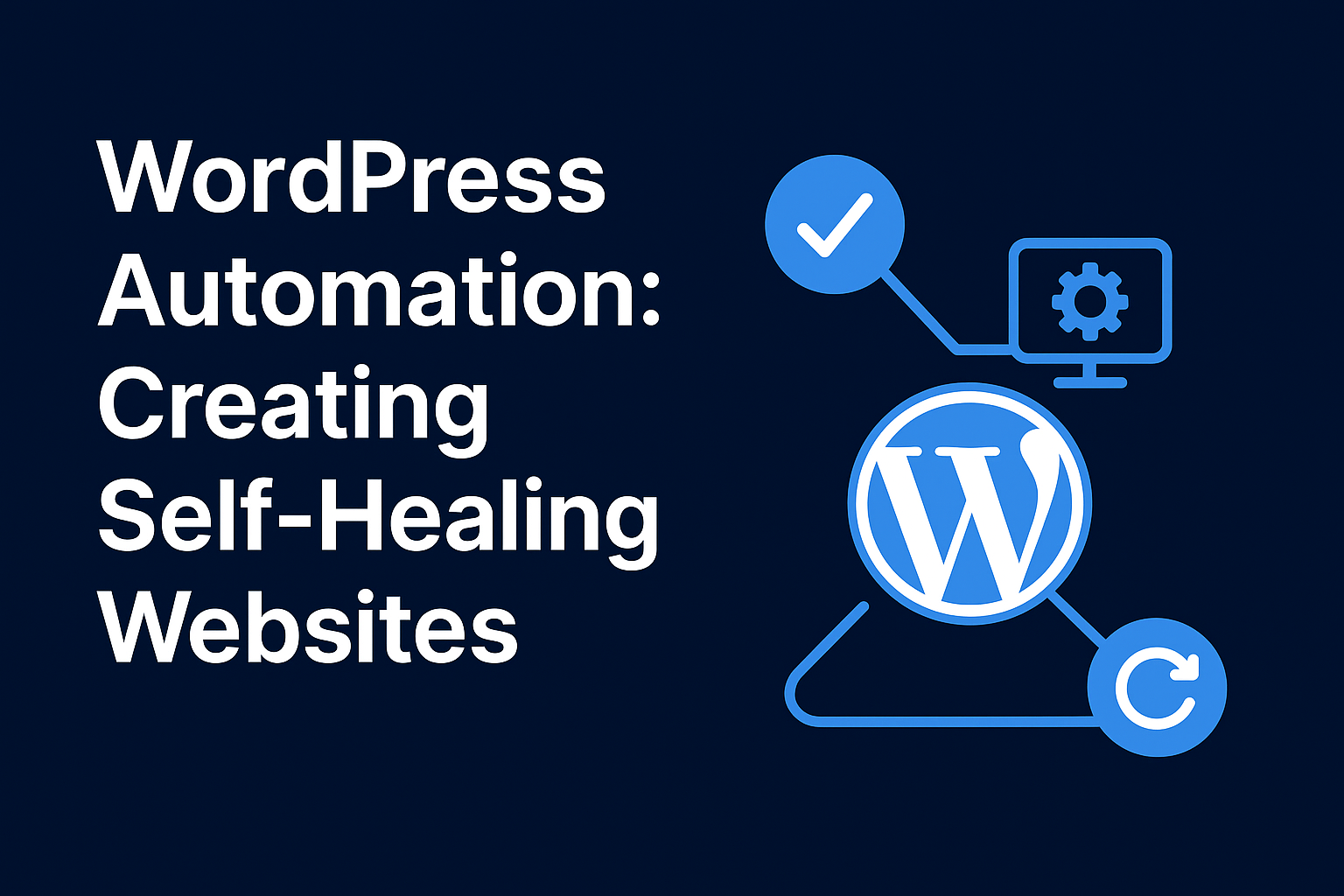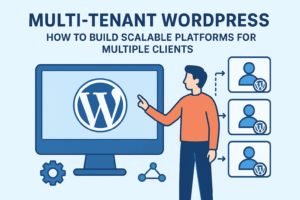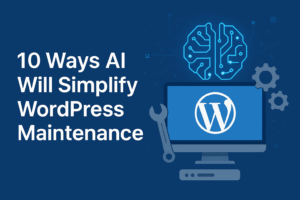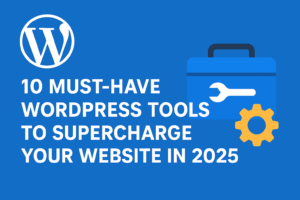WordPress Automation: Creating Self-Healing Websites
Introduction
Keeping WordPress sites healthy 24/7 is hard: updates, plugins, traffic spikes and misconfigurations can break a site at any moment. Self-healing websites aim to detect, mitigate, and automatically recover from common failures with minimal human intervention. This guide explains practical automation patterns, tools, and code snippets to make WordPress resilient in production.
🚦 What is a Self-Healing Website?
A self-healing website can detect operational problems, diagnose the root cause, and take corrective actions automatically — such as restarting services, switching to a fallback, re-deploying a known-good release, or restoring data from backup. For WordPress, that means automating tasks across the stack: PHP / PHP-FPM, webserver, database, storage, CDN, and the application layer.
🧭 Core Principles
- Observability: metrics, logs, traces and synthetic checks.
- Idempotent remediation: fixes must be safe to run multiple times.
- Small blast radius: automatic actions should be limited in scope.
- Fast detection: short detection windows for critical failures.
- Safe rollbacks: ability to revert to last-known-good state automatically.
🔍 Detection: Monitoring & Health Checks
Start with layered checks:
- Uptime checks: ping homepage, wp-admin and REST endpoints (every 30s).
- Application checks: POST to an internal health route (e.g.
/healthz) that probes DB, object cache, and disk write. - Metrics: PHP-FPM queue length, MySQL connections, response latency, error rates.
- Log alerts: watch for fatal PHP errors, 5xx spikes, or repeated plugin errors.
Tools: Prometheus + Grafana, Datadog, New Relic, UptimeRobot, Healthchecks.io, or Cloud provider native monitoring.
🔁 Common Automated Remediations
- Restart services: restart PHP-FPM or PHP workers when queue lengths exceed threshold.
- Cache flush: purge object cache (Redis / Memcached) on memory pressure or stale cache patterns.
- Rollback deploy: automatically revert to previous release if errors > X% after deployment.
- DB read-only fallback: switch to read-only mode during DB failover and show degraded banner.
- Auto-update safe mode: disable recently updated plugin/theme that caused a fatal error.
- Auto-scaling: add instances when CPU or latency thresholds are crossed.
🛠️ Implementation Patterns & Tools
1. Health Endpoint (WordPress)
Add a simple health check endpoint in your mu-plugin or a lightweight plugin:
// mu-plugins/healthz.php
'GET',
'callback' => function () {
global $wpdb;
// DB check
$db_ok = false;
try {
$wpdb->get_results('SELECT 1');
$db_ok = true;
} catch (Exception $e) {
$db_ok = false;
}
// Disk write check
$tmp = wp_tempnam( 'health-check' );
$disk_ok = false;
if ($tmp && file_put_contents($tmp, 'ok')) {
$disk_ok = unlink($tmp);
}
// Object cache check (if available)
$cache_ok = false;
if ( wp_cache_set('health-check', 'ok', '', 10) ) {
$cache_ok = (wp_cache_get('health-check') === 'ok');
} else {
$cache_ok = true; // assume not configured is OK
}
$status = ($db_ok && $disk_ok && $cache_ok) ? 200 : 500;
return new WP_REST_Response([
'db' => $db_ok,
'disk' => $disk_ok,
'cache' => $cache_ok,
'timestamp' => time()
], $status);
}
]);
});
2. Automated Rollback (CI/CD)
Use your CI/CD to run smoke-tests immediately after deploy and rollback on failures. Example (GitHub Actions):
# .github/workflows/deploy.yml
name: Deploy
on:
push:
branches: [ main ]
jobs:
deploy:
runs-on: ubuntu-latest
steps:
- uses: actions/checkout@v4
- name: Build & Deploy
run: |
./deploy-script.sh # deploy to server
- name: Wait for app
run: sleep 10
- name: Smoke tests
run: |
STATUS=$(curl -s -o /dev/null -w "%{http_code}" https://example.com/wp-json/site/v1/healthz)
if [ "$STATUS" -ne 200 ]; then
echo "Health check failed, rolling back"
./rollback-script.sh
exit 1
fi
3. Automated Plugin Disable on Fatal Error
On fatal errors during boot, use a watchdog process to detect repeated fatal logs and disable the offending plugin via WP-CLI:
# example remediation script (bash)
ERRORS=$(grep -c "PHP Fatal error" /var/log/php_errors.log)
if [ "$ERRORS" -gt 10 ]; then
# identify last plugin in stacktrace and disable
wp plugin deactivate suspicious-plugin --path=/var/www/html
fi
4. Backups and Instant Restore
- Create point-in-time backups or DB snapshots.
- Store backups in a separate region/CDN (S3, Backblaze).
- Provide automation to restore DB and media and re-run migrations (keep the process scripted and idempotent).
🔐 Safety: Designing Safe Automation
Automated remediation must be conservative:
- Use escalation windows — try soft fixes first (cache clear), then escalate.
- Rate-limit automated actions to avoid loops (e.g., restart limit 3 times/hr).
- Record every automated action with context and notify the ops/dev team via Slack/email.
- Tag changes with correlation IDs for traceability.
📡 Observability: Logs, Traces, Alerts
Combine these telemetry sources:
- Structured logs: PHP error logs, webserver logs, application logs.
- Traces: instrument slow requests and background jobs (OpenTelemetry / Jaeger).
- Metrics: Prometheus counters for 5xx, response time, job failures.
- Alerting: alert on thresholds and on automation failures (so humans know automation didn’t fully solve the problem).
🧪 Testing Automation
Before enabling in production, test automations in a staging environment that mirrors production. Run chaos experiments:
- Terminate an instance and verify auto-scale + replacement.
- Inject fatal PHP errors and verify plugin-disable flow.
- Block DB and confirm read-only fallback behaves as expected.
🏗️ Architecture Patterns
Recommended architecture for self-healing WP sites:
- Stateless web tier: containers or ephemeral instances behind a load balancer.
- Stateful services isolated: managed DB, object storage, caches.
- Automation engine: lightweight orchestration (Lambda, Cloud Functions, or a small fleet running remediation runners).
- Message bus: for events (e.g., SQS, Pub/Sub) to decouple detectors and remediators.
✅ Deployment Checklist for Self-Healing
- Implement
/wp-json/site/v1/healthzand synthetic checks. - Expose metrics (Prometheus or vendor metrics) and logs to central platform.
- Automate cache purge & DB snapshot on schedule.
- Set up CI/CD with post-deploy smoke tests and rollback scripts.
- Create remediation scripts (restart PHP, clear cache, disable plugin).
- Configure alerts for both incidents and automation outcomes.
- Document runbooks for manual intervention steps.
📣 Real-world Examples & Tools
- WP-CLI — scripting maintenance & remediation (plugin deactivate, db export).
- GitHub Actions / GitLab CI — automated deploy + smoke tests + rollback.
- Prometheus / Grafana — metrics & dashboards.
- Healthchecks.io or UptimeRobot — uptime and cron monitor.
- Cloud provider automation: Lambda / Cloud Functions to run remediation steps securely.
🧾 Example: WP-CLI Remediation Script
#!/bin/bash
# remediation.sh - run from CI or automation runner
WP_PATH="/var/www/html"
cd $WP_PATH || exit 1
# clear cache
wp cache flush --allow-root
# disable slow plugins known to cause issues
wp plugin deactivate plugin-a plugin-b --allow-root
# run DB optimization if necessary
wp db optimize --allow-root
# export debug logs
wp --quiet db export /tmp/db-backup-$(date +%s).sql --add-drop-table --allow-root
📢 Notifications & Operator UX
Always notify humans when automation acts (Slack, email, PagerDuty). Include:
- What triggered the automation
- Actions taken (with timestamps)
- How to manually roll forward or back
- Links to logs and dashboards
🔮 Conclusion
Automating WordPress so it can self-heal means combining observability, safe remediation, and robust CI/CD into one flow. Start small: add a health endpoint, integrate smoke tests into deploys, and script a few safe remediations. Over time expand to auto-rollback, automated plugin quarantining, and full incident-run playbooks — and you’ll dramatically reduce downtime and developer toil.
Related reads on Plugintify:
- From Plugin to SaaS: How to Turn Your WordPress Plugin into a Cloud App
- Serverless WordPress: Running Without Traditional Hosting
- WordPress + WebAssembly: The Future of Plugin Performance
Published by Plugintify — The Hub for WordPress Plugin Developers.




